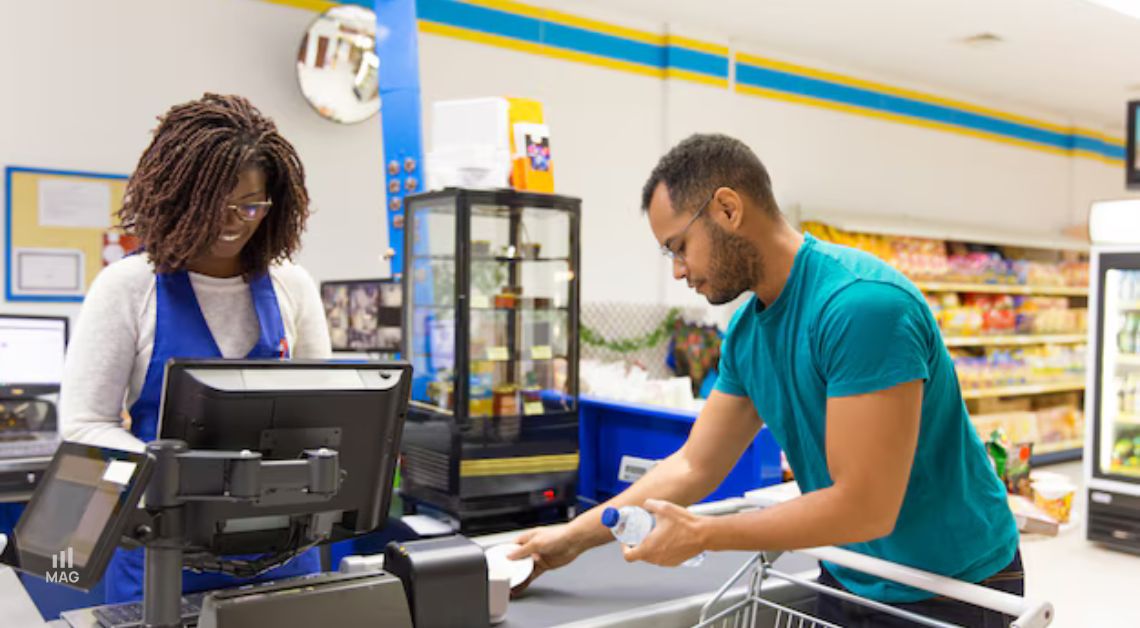
Walmart checkout and payment changes aim to enhance customer convenience with faster transactions, improved security, and seamless integration across physical stores and digital platforms.
Long checkout lines and clunky payment systems plague brick-and-mortar retail, driving customers online. This problem isn’t just about slow service; it’s about losing sales to competitors that prioritize speed and convenience.
Now, with Amazon aggressively refining its physical retail strategy by testing new store formats and pushing its ‘Just Walk Out’ tech, the pressure is on. Retailers like Walmart must adapt or fall behind.
To combat this, Walmart is launching major checkout and payment changes, including faster self-checkout and broader mobile payment options, aiming to create a seamless in-store experience that can compete with the ever-evolving retail landscape.
Walmart checkout and payment changes shoppers can look forward to
An article on e-noticies featured that Walmart is rolling out a significant update to its checkout and payment systems, aiming to enhance speed and security for customers nationwide. The company plans to implement these changes over the coming weeks, with full deployment expected before the 2025 holiday season.
Faster and more secure transactions
The new system is designed to streamline transactions, reducing wait times at both traditional registers and self-checkout lanes. Walmart customers will benefit from improved payment processing, making checkout system smoother and more convenient.
Walmart is also strengthening security measures to protect customer data while ensuring faster payments. The upgrades include better integration with credit cards and mobile payment platforms for seamless transactions.
Expanded mobile payment options
To keep up with evolving consumer preferences, Walmart is expanding its mobile payment integrations. The company will support Apple Pay, Google Pay, and other digital wallets, giving shoppers more flexibility at checkout.
This marks a shift from Walmart’s previous stance on third-party payment services, signaling a commitment to offering more choices for customers. The goal is to make every transaction as quick and effortless as possible.
Improvements to self-checkout lanes
Self-checkout has become a key part of the in-store experience, and Walmart is upgrading its systems to make them even more efficient. The enhancements will enable customers to scan and pay for items faster, reducing bottlenecks at checkout.
With these updates, Walmart aims to minimize wait times, particularly during peak shopping hours. This is part of a broader effort to improve customer flow and enhance the overall shopping experience.
Digital Integration for a seamless experience
Walmart is also enhancing the connection between its digital and physical shopping experiences. The upgraded system will integrate more closely with Walmart’s mobile app, allowing customers to manage their purchases and payments with ease.
This improved synchronization will make it easier for shoppers to track their transactions, whether they’re shopping online or in-store. Walmart hopes this digital push will reinforce its position as a leader in modern retail.
Competing in a changing retail landscape
Clarkston Consulting"The retail industry continues to undergo rapid transformation, primarily driven by evolving customer demands, innovations to technology, and shifting dynamics in the market."
As Walmart checkout and payment changes and modernizes its checkout process, the company is also responding to increasing competition in the retail sector.
Amazon’s attempts to establish a strong physical retail presence have met with mixed results. The e-commerce giant, as reported in Wall Street Journal, has scaled back its Amazon Go convenience stores, closing nearly half of its locations since early 2023. Additionally, ventures into bookstores and fashion outlets have seen closures following operational challenges.
Despite these setbacks, Amazon remains committed to physical retail, shifting focus to licensing its “Just Walk Out” technology and investing heavily in its grocery sector, including Whole Foods Market and Amazon Fresh. In this previous news story our Amazon agency featured, while expansion of Amazon Fresh faced a temporary pause due to unmet expectations, the company has resumed openings, signaling a continued effort to refine its brick-and-mortar strategy.
Amazon tweaks physical presence: grocery and tech lead the way
Amazon Fresh expands and restructures amid store closures
Amazon continues to refine its grocery strategy as it adjusts its Amazon Fresh footprint. According to Progressive Grocer, the company has confirmed the closure of two Amazon Fresh locations—one in Manassas, Va., which ceased operations on March 16, and another in Thousand Oaks, Calif., set to close soon.
At the same time, Amazon is expanding in markets where it sees strong potential. A new Amazon Fresh store is set to open on March 27 in Silver Spring, Md., marking the fifth location in the state. The grand opening will feature a ribbon-cutting ceremony, giveaways, and customer promotions, including a chance to win $500 toward grocery purchases.
Amazon currently operates around 60 Amazon Fresh stores in the U.S. and remains committed to physical retail. To strengthen its grocery business, Whole Foods Market CEO Jason Buechel has been appointed as Amazon’s new VP for worldwide grocery stores. Additionally, the company is restructuring its Worldwide Grocery Stores unit to optimize its operations and better serve customers.
Although Amazon is a newer player in physical retail, it is already making a strong impact in the grocery sector. Ranked No. 2 on Progressive Grocer’s 2024 PG 100 list of top food and consumables retailers in North America, the company remains focused on strengthening its brick-and-mortar presence, refining its strategy to stay competitive in the shifting grocery market.
Amazon Expands Physical Retail Presence to Europe
Amazon is not only strengthening its physical retail footprint in the U.S. but also making strategic moves in Europe. According to Forbes, the company is launching Amazon Parafarmacia & Beauty, a new brick-and-mortar store in Milan, Italy, marking its latest attempt to establish a presence in the beauty and personal care sector.
A New approach to physical retail
Amazon has experimented with various physical retail formats over the past decade, including bookstores, convenience stores, and grocery outlets. Outside of Whole Foods, which it acquired in 2017, many of these ventures have seen limited success.
High-tech beauty shopping
According to Amazon, its Milan store will specialize in “para-pharmaceutical” beauty and personal care products, blending technology with expert guidance. Customers will have access to skincare solutions supported by advanced in-store technology, along with on-site pharmacists and skincare specialists for personalized recommendations.
Giorgio Busnelli, vice president of consumer goods in Europe at Amazon"We're thrilled to announce the opening of Amazon Parafarmacia & Beauty in Milan, a physical store that further enhances and innovates our customers' shopping experience featuring a curated selection of beauty and personal care products."
Expanding across Europe
The launch of Amazon Parafarmacia & Beauty aligns with the company’s broader expansion in the European beauty market. In addition to the Milan store, Amazon is enhancing its dermatological skincare selection online in Germany, France, Italy, Spain, and the U.K., aiming to serve customers both in-store and digitally.






